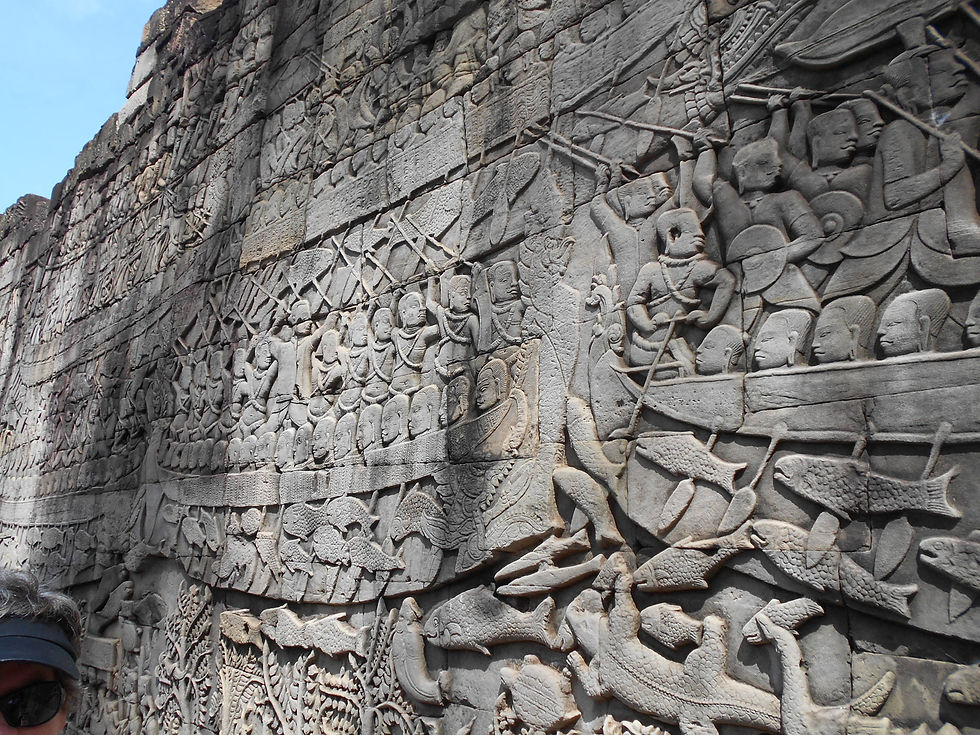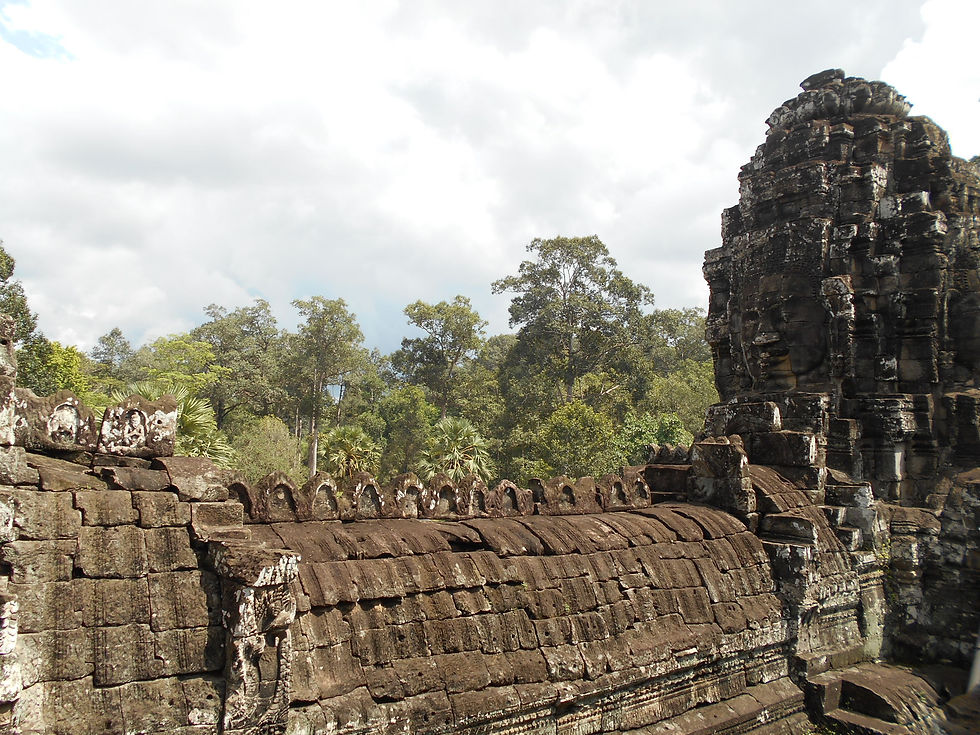Day 14 – 16.10.2016
Today was a long day full of temples. We visited the Angkor complex with three of the temples, all with different construction styles. The first temple we visited was the Bayon temple. The second was the Ta Phrom temple. The third was the Banteay Srei temple.
Angkor is the Khmer word for Capital City. So the Angkor complex is the capital city complex. (Wat means temple, and so Angkor Wat is the temple for the capital city).
So we started off in front of one of the access gates to Angkor Thom, in which the temple of Bayon is located.
Thanks to Wikipedia: „Angkor Thom (Khmer: អង្គរធំ; literally: "Great City"), located in present-day Cambodia, was the last and most enduring capital city of the Khmer empire. It was established in the late twelfth century by King Jayavarman VII. It covers an area of 9 km², within which are located several monuments from earlier eras as well as those established by Jayavarman and his successors. At the centre of the city is Jayavarman's state temple, the Bayon, with the other major sites clustered around the Victory Square immediately to the north. Angkor Thom was established as the capital of Jayavarman VII's empire, and was the centre of his massive building programme. One inscription found in the city refers to Jayavarman as the groom and the city as his bride."
There are several gateways to Angkor Thom each with different purposes which cross the moat around the city. For example a Victory gate 500m north of the east gate, through which the victors of the civil war many centuries ago came back into the city.
We headed through this gateway which is a symbol of Buddhism. Buddhism believes that you cannot be 100% good and not 100% bad. On the lefthand side you see Buddha like (Godlike) figurines. On the righthand side, you can see demon statues. As you walk in the middle to enter you are walking the path of Buddhism.

Buddha Statues (partially reconstructed by the French)

Demon statues (partly reconstructed by the French)

They symbolise a tug of war between good and bad.

The gateway from the other side.

We then got to temple of Bayon.
Thanks again Wikipedia (sorry but I can’t remember all these facts, even though Channa did a really good job explaining and informing us on all the history!)
"The Bayon (Khmer: ប្រាសាទបាយ័ន, Prasat Bayon) is a well-known and richly decorated Khmer temple at Angkor in Cambodia. Built in the late 12th or early 13th century as the official state temple of the Mahayana Buddhist King Jayavarman VII, the Bayon stands at the centre of Jayavarman's capital, Angkor Thom. Following Jayavarman's death, it was modified and augmented by later Hindu and Theravada Buddhist kings in accordance with their own religious preferences.
The Bayon's most distinctive feature is the multitude of serene and smiling stone faces on the many towers which jut out from the upper terrace and cluster around its central peak. The temple is known also for two impressive sets of bas-reliefs, which present an unusual combination of mythological, historical, and mundane scenes. The current main conservatory body, the Japanese Government Team for the Safeguarding of Angkor (the JSA) has described the temple as "the most striking expression of the baroque style" of Khmer architecture, as contrasted with the classical style of Angkor Wat."

Here you can see the many faces peeking through the ruins.

Beautiful carvings.

These carvings especially are very interessting as they depict the life of the people during that time. So for example you can see a battle of the Khmer navy, including all types of animals (e.g. crocodiles and fish).

In the bottom part you can see how they used to carry goods to markets (just like they still do with the weight of two goods balanced through a stick.)

Instead of having hospitals, and because the Khmer empire was that large, all around little huts were built, in which travellers could always find food and water and a place to rest.


You can even see a woman giving birth.

Cock fights (no longer popular in Cambodia)

Hog / Pig fights (no longer popular in Cambodia)

Restling / A type of kick boxing.

Playing a type of chess.


The workers bringing stones for the construction of the temple.

All these faces...



Hello tourist photo!


Eskimo kiss with a statue.

Some of the red paint left over from the inner most temples. (This is on the upper most level of the temple (of three)).


The top of the temple.

One of my favourite carvings.


Even the tiles for the roof weren’t tiles but carved stones.

The reason why we didnt go and visit Angkor Wat straight away was because it was full moon. During full moon the monks go and visit all the important temples in the Angkor complex and pray. (Including the top level of Angkor Wat which was closed today). At the other temples we got to experience music and chanting monks. Quite a special experience.

Postcard reflection photo!

Next stop – the Ta Phrom Temple. Or as it is also lovingly called, the Tomb Raider temple.
Thanks Wikipedia:
Ta Prohm (Khmer: ប្រាសាទតាព្រហ្ម, pronunciation: prasat taprohm) is the modern name of the temple at Angkor, Siem Reap Province, Cambodia, built in the Bayon style largely in the late 12th and early 13th centuries and originally called Rajavihara (in Khmer: រាជវិហារ). Located approximately one kilometre east of Angkor Thom and on the southern edge of the East Baray, it was founded by the Khmer King Jayavarman VII as a Mahayana Buddhist monastery and university. Unlike most Angkorian temples, Ta Prohm is in much the same condition in which it was found: the photogenic and atmospheric combination of trees growing out of the ruins and the jungle surroundings have made it one of Angkor's most popular temples with visitors. UNESCO inscribed Ta Prohm on the World Heritage List in 1992. Today, it is one of the most visited complexes in Cambodia’s Angkor region.

Time for a selfie with the loveliest Channa.


This type of tree (hollow – reminds me strongly of the „tree of life“ in Central and South America!) is found all along this temple. Especially on the temple itself!



A crane a spart of the reconstruction.

The Angelina Jolie - tomb raider tree.


„No, they didnt build the temple around the trees....“


When hinduism was introduced and Buddhism banned, the carvings on the walls were altered to change from Buddhas image to Hinduist images.





A face peeking through the roots of the tree. – Try and spot it!



A special room inside the temple. Back in the days the room was covered and totally dark. The zig zag stone has an architectural background and helps with the carrying of the weight. The holes were filled with gemstones and when a light was ignited in the center, the whole room would glitter and the light would break and zig zag all through the room. Now the gemstones have been robbed or collected.


An example of a linga and yoni – an example of Hinduism. It is not a bathroom...

This is where Angelina Jolie stood...



Now to a carving that is quite extraordinary. Like I said before, the carvings on the walls represented current affairs of what the people saw around in their lives. This carving is theoretically not possible however – it is the carving of a stegosaurus. Make up your own mind...





An example of the restorations done on the temple part. Very much like a large jig saw puzzle. Before the top photo, After the photo on the bottom.

(The After Photo)

The French used a method of labeling all the stones with a number and where they found it for restoration purposes. They then had a map with where which piece would have to go. The same method was used at a different temple, but however the restoration couldnt go ahead as the Khmer Rouge took over. The map depicting which stone should go where was taken away and safeguarded, however as that building later burnt down, one temple as several hundreds of stones in front of it with no means to restore it.

Puzzle pieces.


After the visit of these two temples we were in desperate need of lunch. Being all templed out isn’t recommendable if you have another temple to visit in the afternoon.
I had the largest coconut so far and it was wonderful. Ice cold and so full of juice that it took forever to drink all of it.

I also had a traditional Cambodian soup , that was lovely with a bit of rice.

Off to the next temple - the Banteay Srei.
Thank you Wikipedia:
„Banteay Srei or Banteay Srey (Khmer: ប្រាសាទបន្ទាយស្រី) is a 10th-century Cambodian temple dedicated to the Hindu god Shiva. Located in the area of Angkor in Cambodia. It lies near the hill of Phnom Dei, 25 km (16 mi) north-east of the main group of temples that once belonged to the medieval capitals of Yasodharapura and Angkor Thom.[1] Banteay Srei is built largely of red sandstone, a medium that lends itself to the elaborate decorative wall carvings which are still observable today. The buildings themselves are miniature in scale, unusually so when measured by the standards of Angkorian construction. These factors have made the temple extremely popular with tourists, and have led to its being widely praised as a "precious gem", or the "jewel of Khmer art."
This temple was built by the mentor of the king:
„Consecrated on 22 April 967 A.D., Bantãy Srĕi was the only major temple at Angkor not built by a monarch; its construction is credited to the courtiers named Vishnukumara and Yajnavaraha/ Yajñavarāha (modern Khmer: យជ្ញវរាហៈ), who served as a counsellor to king Rajendravarman II (modern Khmer: ព្រះបាទរាជេន្រ្ទវរ្ម័ន).“
It served as a sort of university back then, with all the scriptures around and promoting artists to come and learn about carving and other artistic skills as well as providing knowledge.
Here an image of the different temples in comparison to other civilisations.

Beautiful carvings – even more intricate than the other temples.

Statues looking like torches of fire.


The same technique used here as in the temple structures in Central and South America, using a „positive / negative“ jig saw puzzle method, instead of any mixtures used to stick the stones together.

The temple.

Important inscriptions at its entrance.


Another postcard reflection!








Tourist shot! :)

Back on the road we got and headed to the hotel. Of course we had to stop along the road to try the developing bird embryo egg. I couldn’t do it. Just the idea of eating an egg with a beak and feathers – no thank you. I know I have tried quite a lot of different things on this trip but this isn’t one of them. (Apparently due to the after taste it wasn’t recommended either in hindsight!)

Back to the hotel and instead we listened to our craving of Mexican food. It was surprisingly good. I got a little over excited and had chicken quesadillas.

And a burrito with nachos and guacemole. Very very big portions though!

Here a view of Siem Reaps „Pub Street“








